《营养生理学》课程教学课件(PPT讲稿)第六章 主要营养物质代谢的调控
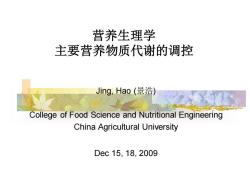
营养生理学主要营养物质代谢的调控Jing,Hao (景浩)College of Food Science and Nutritional EngineeringChina Agricultural UniversityDec 15, 18, 2009
营养生理学 主要营养物质代谢的调控 Jing, Hao (景浩) College of Food Science and Nutritional Engineering China Agricultural University Dec 15, 18, 2009
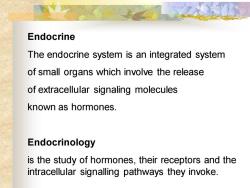
EndocrineThe endocrine system is an integrated systemof small organs which involve the releaseof extracellular signalingmoleculesknown as hormonesEndocrinologyis the study of hormones, their receptors and theintracellular signalling pathways they invoke
Endocrine The endocrine system is an integrated system of small organs which involve the release of extracellular signaling molecules known as hormones. Endocrinology is the study of hormones, their receptors and the intracellular signalling pathways they invoke
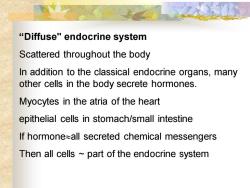
"Diffuse" endocrine systemScattered throughout the bodyIn addition to the classical endocrine organs, manyothercellsinthebodysecretehormones.Myocytes in the atria of the heartepithelial cells in stomach/small intestineIf hormone~all secreted chemical messengersThen all cells ~ part of the endocrine system
“Diffuse" endocrine system Scattered throughout the body In addition to the classical endocrine organs, many other cells in the body secrete hormones. Myocytes in the atria of the heart epithelial cells in stomach/small intestine If hormoneall secreted chemical messengers Then all cells ~ part of the endocrine system
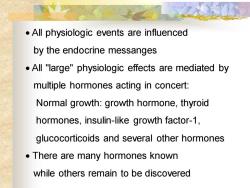
· All physiologic events are influencedby the endocrine messanges·All "large" physiologic effects are mediated bymultiple hormones acting in concert:Normal growth: growth hormone, thyroidhormones, insulin-like growth factor-1,glucocorticoids and several other hormones.There are many hormones knownwhile others remain to be discovered
• All physiologic events are influenced by the endocrine messanges • All "large" physiologic effects are mediated by multiple hormones acting in concert: Normal growth: growth hormone, thyroid hormones, insulin-like growth factor-1, glucocorticoids and several other hormones • There are many hormones known while others remain to be discovered
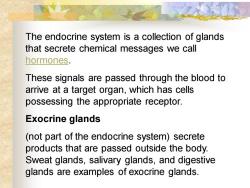
The endocrine system is a collection of glandsthat secrete chemical messages we callhormones.These signals are passed through the blood toarrive at a target organ, which has cellspossessing the appropriate receptor.Exocrineglands(not part of the endocrine system) secreteproducts that are passed outside the body.Sweat glands, salivary glands, and digestiveglands are examples of exocrine glands
The endocrine system is a collection of glands that secrete chemical messages we call hormones. These signals are passed through the blood to arrive at a target organ, which has cells possessing the appropriate receptor. Exocrine glands (not part of the endocrine system) secrete products that are passed outside the body. Sweat glands, salivary glands, and digestive glands are examples of exocrine glands
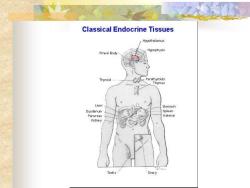
Classical Endocrine TissuesHypothalamusPineal BodyParathuroidThyraiciuerStomachDuodenumSpleenAdrenalPancreasKidreOua
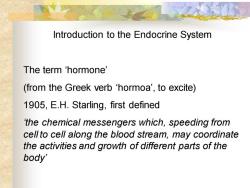
Introduction to the Endocrine SystemThe term ‘hormone'(from the Greek verb ‘hormoa', to excite)1905, E.H. Starling, first defined‘the chemical messengers which,speedingfromcellto cell alongthe blood stream,may coordinatethe activities and growth of different parts of thebody
Introduction to the Endocrine System The term ‘hormone’ (from the Greek verb ‘hormoa’, to excite) 1905, E.H. Starling, first defined ‘the chemical messengers which, speeding from cell to cell along the blood stream, may coordinate the activities and growth of different parts of the body’
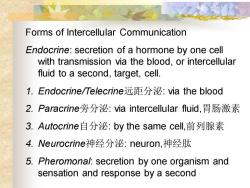
Forms of Intercellular CommunicationEndocrine: secretion of a hormone by one cellwith transmission via the blood, or intercellularfluid to a second, target, cell.1.Endocrine/Telecrine远距分泌:viatheblood2.Paracrine旁分泌:viaintercellularfluid,胃肠激素3.Autocrine自分泌:bythesamecell.前列腺素4.Neurocrine神经分泌:neuron,神经肽5. Pheromonal: secretion by one organism andsensation andresponse bya second
Forms of Intercellular Communication Endocrine: secretion of a hormone by one cell with transmission via the blood, or intercellular fluid to a second, target, cell. 1. Endocrine/Telecrine远距分泌: via the blood 2. Paracrine旁分泌: via intercellular fluid,胃肠激素 3. Autocrine自分泌: by the same cell,前列腺素 4. Neurocrine神经分泌: neuron,神经肽 5. Pheromonal: secretion by one organism and sensation and response by a second
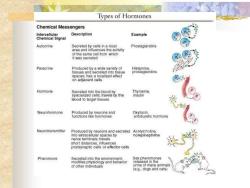
Types of HormonesChemical MessengersDescriptionIntercellularExampleChemical SignalAutocrineSecreted by cells InalocalProstaglandinsareaandintluencestheactivityofthesamecell tromwhichitwassecretedParacrineHistaminProducedbyawidevarietyofprostaglandinslissuesandseratadintotspaces:hasalocalizedetleconadjacentcellsHormoneSecreted intothebloodtThyroxine,cializedcells.fraveinsulinblood to target tissuesOxytocirNeurohormoneProducedbyneuronsandantidiuretic hormonefunclionslikehormonesNeurotransmitterProduced by neurons and secreted Acetyicholinenloextracnotepinephrinlarspacesbynerveterminals:travelsshort.distanceslntluencespostsynaptic cells oreflectorcelsPheromoneSexpheroSecreted intothe emvironmentronesmoditiesphysiologyandbehavioreleasedintheurineofmaanimaot other individuals(e.g.,dogs and cats)

Characteristics of hormoneA hormone is a chemical messenger that is:. Secreted into body fluids (usually the blood)by specialized cells, e.g endocrine ornerve cells·Effective in minute amounts· Detected only by "target" cells possessingspecial protein receptors on cell membranes.Often regulated by a second antagonistic hormone
Characteristics of hormone A hormone is a chemical messenger that is: • Secreted into body fluids (usually the blood) by specialized cells, e.g endocrine or nerve cells • Effective in minute amounts • Detected only by "target" cells possessing special protein receptors on cell membranes • Often regulated by a second antagonistic hormone
按次数下载不扣除下载券;
注册用户24小时内重复下载只扣除一次;
顺序:VIP每日次数-->可用次数-->下载券;
- 《营养生理学》课程教学课件(PPT讲稿)第五章 呼吸生理(respiration).ppt
- 《营养生理学》课程教学课件(PPT讲稿)第四章 血液(blood)第三节 生理性止血 hemostasis 第四节 血型与输血.ppt
- 《营养生理学》课程教学课件(PPT讲稿)第四章 血液(blood)第一节 血液的组成和理化特性 第二节 血细胞生理.ppt
- 《营养生理学》课程教学课件(PPT讲稿)第三章 消化与吸收 第三节 吸收.ppt
- 《营养生理学》课程教学课件(PPT讲稿)第三章 消化与吸收 第二节 食物的消化.ppt
- 《营养生理学》课程教学课件(PPT讲稿)第三章 消化与吸收 第一节消化系统的组成与功能.ppt
- 《营养生理学》课程教学课件(PPT讲稿)第二章 细胞的基本功能 第四节 肌细胞的收缩功能 Contraction of muscle cell.ppt
- 《营养生理学》课程教学课件(PPT讲稿)第二章 细胞的基本功能 第三节 细胞的生物电现象.ppt
- 《营养生理学》课程教学课件(PPT讲稿)第二章 细胞的基本功能 第一节 细胞膜的物质转运 第二节 细胞跨膜信号转导功能.ppt
- 《营养生理学》课程教学课件(PPT讲稿)第一章 绪论 Physiology for Nutrition(中国农业大学:石英).ppt
- 《营养生理学》课程教学课件(教案讲义)06 主要营养物质代谢的调控.doc
- 《营养生理学》课程教学课件(教案讲义)05 泌尿系统.doc
- 《营养生理学》课程教学课件(教案讲义)04 呼吸生理.doc
- 《营养生理学》课程教学课件(教案讲义)02 细胞基本功能.doc
- 《营养生理学》课程教学课件(教案讲义)03 消化生理.doc
- 《营养生理学》课程教学课件(教案讲义)04 血液生理及循环系统.doc
- 《营养生理学》课程教学课件(教案讲义)01 绪论.doc
- 《食品质量保证》课程教学课件(PPT讲稿)第二章 食品安全管理体系(HACCP).ppt
- 《食品质量保证》课程教学课件(PPT讲稿)第一章 绪论.ppt
- 《食品质量保证》课程教学课件(PPT讲稿)第三章 统计过程控制(SPC)、统计质量控制(SQC).ppt
- 《营养学》课程教学大纲(Nutrition).pdf
- 《营养学》课程授课教案(讲义)第一章 绪论 第二章 食物的消化与吸收 第三章 基础营养.doc
- 《营养学》课程授课教案(讲义)第四章 不同人群食品的营养要求 第五章 各类食物的营养价值 第六章 食品的营养素强化 第七章 食物与健康 第八章 社区营养 第九章 营养与农业.doc
- 《营养学》课程教学资源(实验指导)实验一 体格测量.doc
- 《营养学》课程教学资源(实验指导)实验二 血红蛋白的测定(氰化法)、尿中还原型抗坏血酸测定.doc
- 《营养学》课程教学资源(实验指导)实验三 尿中还原型抗坏血酸测定.doc
- 《营养学》课程教学资源(实验指导)实验四 膳食调查.doc
- 《营养学》课程复习题题(含答案)基础营养部分.pdf
- 中国农业大学:《基础营养学》课程教学课件(PPT讲稿)食物的体内过程3/7.ppt
- 中国农业大学:《基础营养学》课程教学课件(PPT讲稿)绪论 Nutrition(主讲:何计国).ppt
- 中国农业大学:《基础营养学》课程教学课件(PPT讲稿)食物的体内过程2/7.ppt
- 中国农业大学:《基础营养学》课程教学课件(PPT讲稿)食物的体内过程1/7.ppt
- 中国农业大学:《基础营养学》课程教学课件(PPT讲稿)食物的体内过程5/7.ppt
- 中国农业大学:《基础营养学》课程教学课件(PPT讲稿)食物的体内过程6/7.ppt
- 中国农业大学:《基础营养学》课程教学课件(PPT讲稿)食物的体内过程7/7.ppt
- 中国农业大学:《基础营养学》课程教学课件(PPT讲稿)食物的体内过程4/7.ppt
- 中国农业大学:《基础营养学》课程教学课件(PPT讲稿)碳水化合物.ppt
- 中国农业大学:《基础营养学》课程教学课件(PPT讲稿)蛋白质2/2.ppt
- 中国农业大学:《基础营养学》课程教学课件(PPT讲稿)脂类.ppt
- 中国农业大学:《基础营养学》课程教学课件(PPT讲稿)蛋白质1/2.ppt
